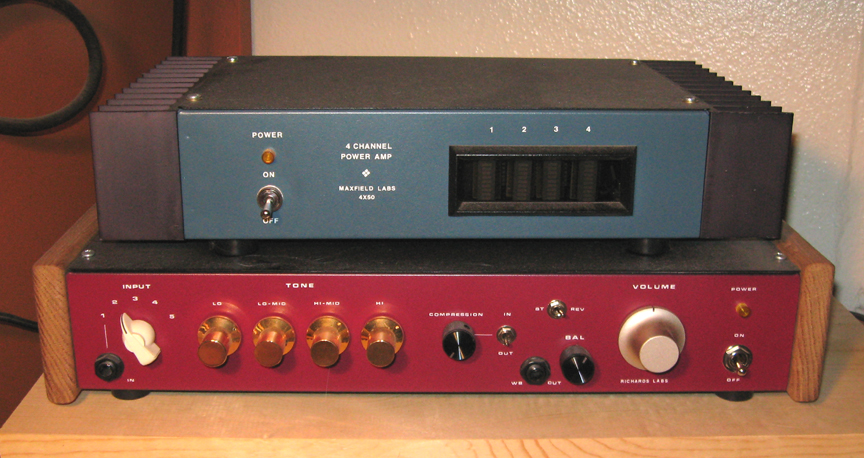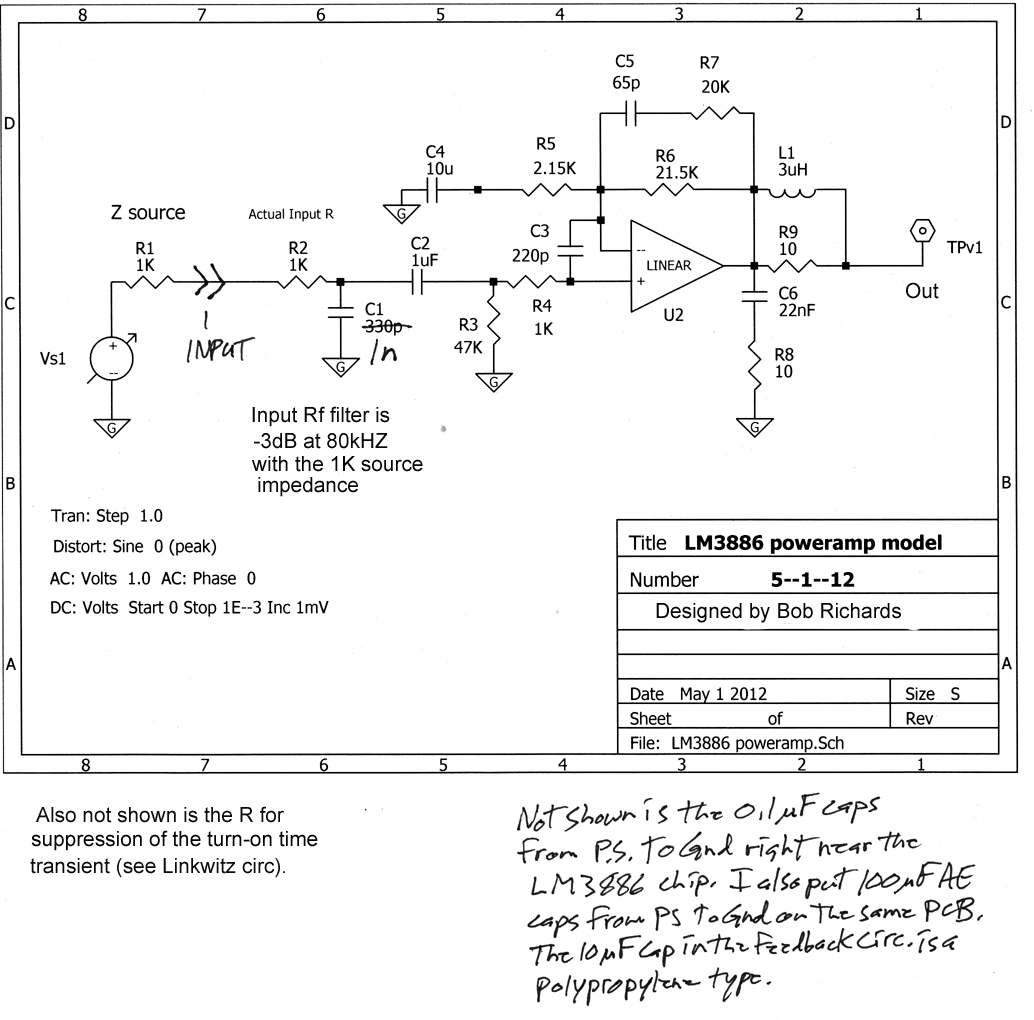
by Bob Richards
Now that I'm totally sold on active crossovers and active EQ to acoustically flatten low bass down to 30HZ, I need more poweramps, but have limited space. So after a bunch of research I decided to build a 4 channel 3886 power amp in a Hammond 3 X 12 X 8 inch chassis (external heat sinks make the width about 16 inches). Linkwitz used this poweramp chip in his Pluto bi-amp'd speaker system, so I knew going into it that this chip can't be too bad. One of the important things about it is that it doesn't put out a voltage transient at turn-on, so it's safer for when you want to directly hook it to a tweeter, as is the case with active crossovers. He shows his circuit on his website, so I had a good reference to start from. I researched several other designs on the web that used this chip, and then came up with what I thought was the best way to use it. With the approximately 32VDC bipolar power supply I put together, I'm getting 50+ watts rms into 10 ohms on my bench, per channel, which is enough for me.
Back in the old days (early 1980's) I studied power amp circuit design heavily, and started building my own design, but then had better things to do with my time, so I never finished it. I eventually realized that the most important feature of any power amp is how it handles abuse and/or blows up if it ever does, and whether or not it will also blow your speakers when that happens. There's also the issue of temperature tracking of the output devices so push-pull crossover distortion can be kept VERY minimal. I realized that these chips, and many other designs have thought this all through and come up with circuits that blow relatively elegantly and have very little crossover distortion ever. The LM3886 application notes from TI actually talk about the crossover distortion issue, citing their very good in-chip temp tracking, so on this occasion I went with it.
Here it is finished, with my Tonemeister Preamp below it.

Below is the circuit model as viewed in the 5SPICE simulation program. Notice the passive Rf filter at the input, and the output filter. They keep it in its "happy" zone.

Sorry about the sloppy documentation. One of the reasons I love this chip is because it makes NO transient at all during turn-on or turn-off, which makes it safe to hook directly up to an expensive tweeter when using active crossovers ahead of the power amp.
Many poweramps don't have that feature.

It's a little tricky to fit everything inside this chassis. You've got to plan every detail out ahead of time, or learn that lesson the hard way. Toroidal power transformers radiate less than the wires coming out of them.
I laid out the board with the ExpressPCB software and had them make them for me. The board design was based on my SPICE analysis model.
Then I played with it on the bench to get the phase margin as good as I could, hence the cap on the back of the board.
I feel that any poweramp should have level indicators, so you can see when you're getting close to clipping distortion, so I whipped up those circuits too (below on left). I was lucky to find a great bezel window for that.
Then I needed a +/- 15V supply for those opamps. The 3AG internal fuses are at the outputs feeding the speakers.
Above on the left is the four peak level indicator boards, in between the toroid power tranny and one channel of 3886. On the right above is the star center ground post.
All power supply grounds are tied together independantly, and a wire from there goes to the star center post, where all other grounds come together.
I got a tinted window for the bezel at Tap Plastics for real cheap. Clear just didn't look right.
Above on the left you can see the spurious oscillation that occurs when the waveform negative half cycle is coming out of clipping. That's not acceptable.
After trying a few things on the bench and adding that mica cap to the back of the board and possibly adjusting some of the other cap values, I got the waveform on the right. Not quite perfect, but not bad either.
This is where many poweramp builders fall short. You need to make sure the amp is stable and safe for your speakers when over driven.
It sounds great to me. I'm actually gathering parts to build another one. Finding good looking heat sinks and a bezel is difficult. I found some nice gold anodized heatsinks in China, but then you've got to pay various duty charges.
Click here to go to audio project index.
Click here to go to front page of website.